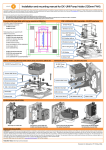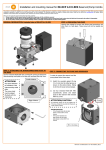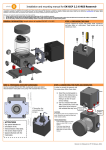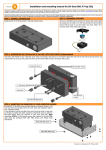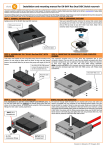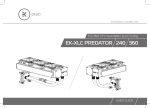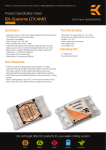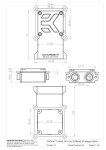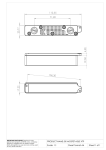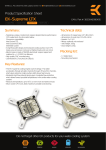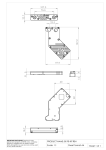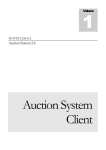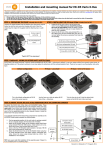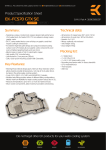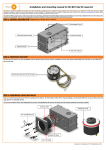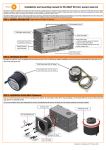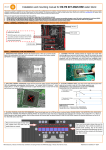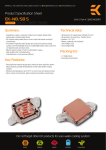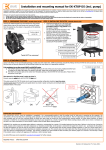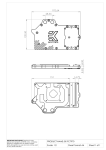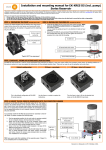Download EK Water Blocks 3830046999603
Transcript
EK-Ekoolant MATERIAL SAFETY DATA SHEET 1. IDENTIFICATION OF THE SUBSTANCE/PREPERATION AND COMPANY Product Name: EK‐Ekoolant Use: Liquid for Corrosion protection and heat transfer for computer water cooled systems. Manufacturer/Supplier: EKWB d.o.o. Address: Pot za Brdom 100, 1000 Ljubljana, Slovenia ‐ EU Telephone number: +386 1 620 46 90 E‐Mail: [email protected] 2. COMPOSITION/INFORMATION ON PRODUCT INGREDIENTS Low oral toxicity proprietary antifreeze formulation classified as Generally Regarded as Safe as a food additive and not classified as harmful for handling or transport purposes. However we do recommend good working practices are employed and personal protection gear is worn when handling any chemical. COMPONENT NAME 1. Propane‐1,2‐diol with corrosion inhibitors. CAS no CONCENTRATION R PHASES 57‐55‐6 10‐25% Not Classified 3. HAZARDS IDENTIFICATION Main Hazards: Not classified as a hazard or environmental hazard under current legislation 4. FIRST AID MEASURES After Inhalation: Tickle of the throat and heavy breathing may occur. Remove person to fresh air immediately. Perform artificial respiration if breathing has stopped. Keep the affected person warm and at rest. Get medical attention. After eye contact: Irritation and reddening can occur. Wash eyes promptly and rinse for 15 minutes. Get medical attention. After skin contact: Irritation of the skin can occur in the contact area. Remove affected person from source of contamination. Wash skin with soap or mild detergent. After ingestion: Can cause sickness. Rinse mouth thoroughly. Do NOT induce vomiting. Get medical advise. 5. FIRE-FIGHTING MEASURES Extinguishing Media: Use appropriate extinguishing media for surrounding fire: ‐ Alcohol resistant foam ‐ Carbon Dioxide (CO2) ‐ Dry chemicals, etc. Special Hazards of Product: Acrid smoke/fumes. Carbonyl compounds. Acetic acid. Protective equipment for firefighting: Wear none air circulation depended respirator/apparatus. 6. ACCIDENTAL RELEASE MEASURES Personal Precautions: No special precautions necessary. Environmental Precautions: Prevent the material from entering drains, sewers, ground or water courses without pre‐treatment. Spillages: Drain the product if necessary. Clean with absorbent material and dispose. 7. HANDLING AND STORAGE Handling: No special measures necessary. Protect against fire and explosion. Take precautionary measures against static discharge. Storage: Containers/Bottles should be: tightly sealed and dry, kept in cool and sun‐protected place. An original HDPE/PET bottle is advised. Page 1/3 8. EXPOSURE CONTROLS / PERSONAL PROTECTION Engineering Control Measures: Engineering methods to prevent or control exposure are preferred. Methods include process or personnel enclosure, mechanical ventilation (dilution and local exhaust), and control of process conditions. Respiratory Protection: Respiratory protection if there is a risk of exposure to high vapour concentrations. Hand Protection: wear PVC gloves Eye Protection: Chemical splash goggles or face shield must be worn. Body protection: Wear overall or apron. 9. PHYSICAL AND CHEMICAL PROPERTIES Physical State: Liquid. Colours: Blue, Green, Red, Clear. Odour: Almost odourless. pH at 500g/l, 24°C: between 7,0 – 8,0 Density (g/cm3): 1,05 +/‐ 3% depending on the water ratio concentration. 10. STABILITY AND REACTIVITY Stability: Stable under normal conditions. Materials to Avoid: Strong oxidizing agents. Hazardous Decomposition Products: None known. 11. TOXICOLOGICAL INFORMATION Acute Toxicity: LD 50/oral/rat > 20 g/kg Irritancy – Eyes: This material is irritating to mucous membrane/eyes. Irritancy – Skin: This material is non‐irritant to the skin (the Draize test by FDA). 12. ECOLOGICAL INFORMATION Mobility: The product will dissolve rapidly in water. Ecotoxicity rating: ‐ Fish LC50 (96h) : 0,1g/L, Oncorhynchus Mykiss ‐ Algae’s EC50 (72h) > 0,1g/L. ‐ Bacteria > 1 g/L. Daphnids (acute) EC50 (48h) : >0,1g/L 13. DISPOSAL CONSIDERATIONS Product Disposal: Dispose according to local/national regulations. Purified bottle: Can be disposed with normal trash according to local/national waste regulations. Unpurified bottle: Should be cleaned by appropriate methods and then re‐used or disposed in same manner as contents. 14. TRANSPORT INFORMATION Not hazardous material under transport regulations. 15. REGULATORY INFORMATION Regulations of the EU (classifications)/ National Regulations R‐Phase: N/A S‐Phrase: N/A EC Annex 1 Classification: N/A Hazardous components for labeling: According to EEC directives ‐ not subject to labelling Other regulations: Water‐polluting class: NWP (not water‐polluting) Page 2/3 16. OTHER INFORMATION Date of first issue of MSDS 01.09.2011 Date of last revision of MSDS data 01.09.2011 Disclaimer of liability: The above information was obtained from sources which we believe to be accurate. The sole purpose of the datasheet is to provide guidance on the safe handling and use of the respective product. The information is provided without warranty, express or implied regarding its correctness. It does not form part of any product specification or contract. It is not practical for the information to cover every conceivable application of the product. This MSDS was prepared and is to be used only for this product. It is the responsibility of the user to evaluate the information for their own particular purpose. In no event shall the company be held liable for any injury, loss or damage resulting from its use. If the product is used as a component in another product, this MSDS information may not be applicable. Page 3/3



